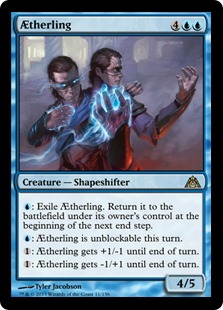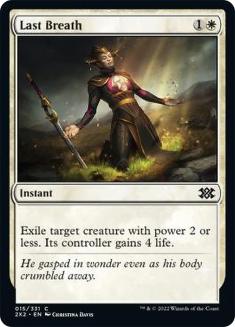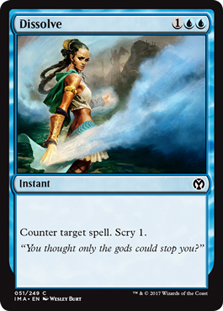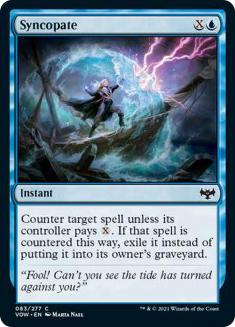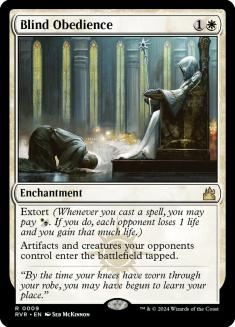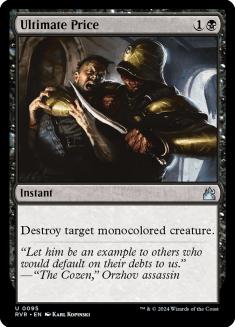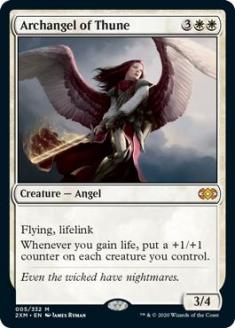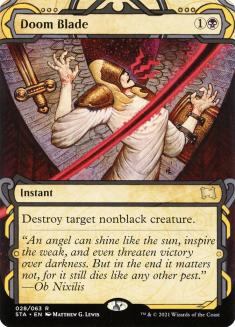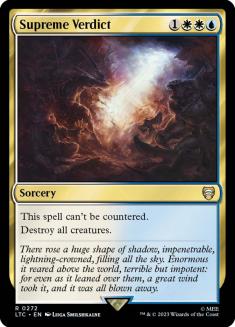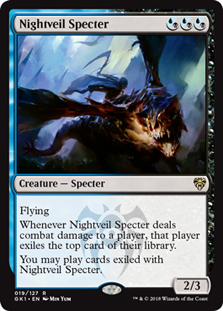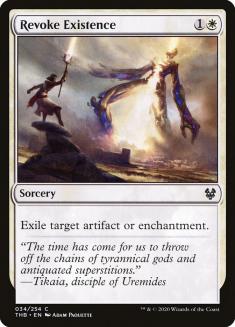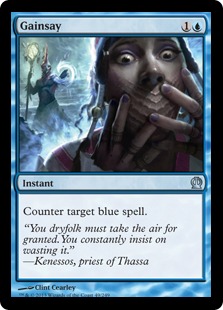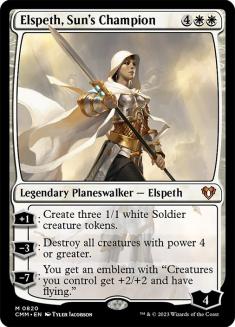For me, it started in December. I was perfectly content calling it quits on Sphinx’s Revelation. For the majority of the time that Sphinx’s Revelation has been in Standard, I have been happy trying to beat it with some family-friendly green creatures, such as Thragtusk. You can draw your five cards; I’m just going to grind you down one beast at a time. I’ll drain you out eventually one Obzedat trigger at a time. I’ll slowly peck away at your life total until you catch back up with a giant Sphinx’s Revelation and then you easily win from there . . . one Avacyn’s Pilgrim attack at a time.
Okay, so maybe things weren’t always roses against Sphinx’s Revelation, but for the most part I liked battling against it more than I liked battling with it.
Last December I ended up switching to casting Sphinx’s Revelation through an unlikely series of events. I was playing a B/R/W Heliod deck. I realized that the deck wasn’t quite there in terms of power level, but I was impressed with Blood Baron of Vizkopa, who had won me many games. I started searching for the best Blood Baron shell.
After trying out a number of decks that didn’t really cut it, I was considering just calling it quits on Blood Baron of Vizkopa and going back to playing Mono-Black Devotion. Then on a whim I decided to try Esper with Blood Baron and see if there was any value there. The general consensus at the time was that Esper sucked and wasn’t even worth trying. If there’s one thing I love more than playing powerful cards, it’s proving people wrong.
I started winning with the deck. Then I started winning a lot. Rather than try to play U/W Control with Doom Blade, I decided that I wanted to play something more midrangey. I eschewed countermagic, which wasn’t fantastic against decks that aimed to strip your hand, and relied instead on proactive threats to close the game against those decks. The result was an SCG Invitational Top 8 in Las Vegas with this deck:
Creatures (4)
Planeswalkers (7)
Lands (27)
Spells (22)
- 3 Thoughtseize
- 4 Supreme Verdict
- 4 Detention Sphere
- 4 Sphinx's Revelation
- 1 Ultimate Price
- 2 Dimir Charm
- 3 Devour Flesh
- 1 Hero's Downfall
Sideboard

This deck got me hooked on Esper again. Sorry, phonics, you’re old news. Since that Invitational, I have tried to bring Esper back a few times, with varying success. The most recent time I tried, I ended up giving it up because Blood Baron of Vizkopa wasn’t cutting it against G/R Monsters.
However, another couple of months have passed, and it looks like it’s time to revive the old boy. An Esper deck featuring the full twelve Temples made Top 8 of a Grand Prix in Melbourne a few weeks ago, and since then I’ve been focused solely on tweaking that deck.
This deck is a lot more U/W splash black than it is pure Esper, but I think playing U/W Control with Doom Blade is actually a good place to be. Having access to Dissolve and Syncopate makes the control matchups significantly better, but having access to Doom Blade makes cards like Stormbreath Dragon and Mistcutter Hydra far less oppressive.
I really liked the position the deck had in the metagame, and I was interested in giving it a test drive to see how it performed. While I had been doing well with it on Magic Online, it’s not always an optimal testing ground. The online metagame is skewed by card availability and other factors and rarely provides an honest look into the real metagame.
Thankfully, I was heading to North Carolina along with Chris VanMeter and Brad Nelson to play in a couple of IQs last weekend, which would be the perfect testing ground. I decided that I would play Esper on Saturday, and depending on how I did and how I felt about the deck, I would either play it again on Sunday or B/W Midrange.
This is the list I played on Saturday. Twelve Post? Not familiar. Let’s try Twelve Temple:
Creatures (1)
Planeswalkers (7)
Lands (27)
Spells (25)

I won the Super IQ on Saturday after going 0-2 drop. What I mean by that is that I got smashed round 1 by R/W Burn and then played a friend of mine in round 2 who conceded to me even though he ended up beating me. I felt bad about it, but he insisted that I needed the points more.
Having been given new life, I decided that I wasn’t going to waste it. Up to that point, my draws had been exceptionally bad, and I hadn’t played optimally with the few decisions I’d actually gotten to make. I gave myself a bit of an internal pep talk and ended up not losing again the rest of the event.
It’s amazing how one little thing can affect an entire event. I should have been dead after round 2, but instead I won the whole tournament. It just goes to show that you shouldn’t always put your faith in pure results alone. Had I not gotten a concession round 2, I probably would have given up on the deck. Going 0-2 drop will destroy your confidence in a list, even if the list is very good.
One major change I made to the deck from the list that made Top 8 of the Grand Prix in Melbourne was to add the full set of Nightveil Specter to the sideboard in place of Blood Baron of Vizkopa. I think Specter is absolutely insane out of the sideboard. I’m honestly not sure why this idea doesn’t get any respect and hasn’t caught on at all because it’s actually just good in nearly every single matchup.
R-E-S-P-E-C-T-E-R, find out what it means to me.*
Nightveil Specter out of the board is good against Mono-Blue Devotion, Mono-Black Devotion, and any control deck. It’s also fine against burn decks and hyperaggressive creature decks because it blocks well. I won the Super IQ finals against Burn with Specter. I beat Maze’s End on Sunday with Specter. One of the best ways to beat B/W Midrange post-board is to cast their Blood Baron of Vizkopa and Hero’s Downfall with Specter since they can’t actually beat their own cards. Decks like G/R Monsters and R/W Devotion are some of the only matchups where you don’t want Specter.
Nightveil Specter plus Thoughtseize puts your opponent in a really awkward position. They can leave in their dead removal spells, which lets you beat them by Thoughtseizing their important cards and then win with yours since they’re stuck with dead removal in hand. Or they don’t leave in their removal spells, and then you can just beat them with Specter. It’s very hard to play optimally against the Specter sideboard plan even if you know it’s coming. If you don’t know it’s coming, well, then you’re just dead.
After I won the Super IQ on Saturday with the deck, Brad decided to play my exact 75 on Sunday. He went on to win the IQ, beating me in the Top 4. The deck performed quite well for both of us. Well, it performed well except for my Top 4 match against Brad, where I mulled to four in game 1 and didn’t cast a relevant spell in game 2. There is no justice.
I think that Blood Baron of Vizkopa is just worse than Archangel of Thune in the sideboard. Archangel is good against a wide variety of decks, including Mono-Black Devotion and B/W Midrange, while Blood Baron of Vizkopa is good against a much narrower range, mostly just Mono-Black Devotion and B/W Midrange.
I also hate Azorius Charm but think that it might be a necessity. However, I’m interested in trying out a list that doesn’t play it and instead features more effective removal spells. This is the list I’m considering moving forward.
Creatures (1)
Planeswalkers (7)
Lands (27)
Spells (25)

Blind Obedience gains a lot of value thanks to the newfound prevalence of R/W Burn. Blind Obedience is already very good against G/R Monsters because it turns Xenagos, Stormbreath Dragon, and Mistcutter Hydra into a bunch of chumps. "Nice tapped Satyr token you got there!" "Oh, you tapped out for a Mistcutter for seven that doesn’t hit me and is just going to die to my Elspeth next turn? Fantastic. A real delight."
Against R/W Burn the game is usually a slower affair where they (surprisingly enough) win by grinding you out since a lot of your cards don’t interact very well with theirs. Occasionally they just beat you senseless with cards like Toil // Trouble, but for the most part the game extends to at least turn 6 or 7, when you end up losing because you just didn’t have a way to close the game while they drew more and more burn.
Blind Obedience lets you extort off of all of your spells, which over the course of a game will actually counter a few burn spells. Countering one or two burn spells is often all you need to turn the corner into big Sphinx’s Revelation and Archangel of Thune. Blind Obedience also keeps Chandra’s Phoenix from smashing you the turn she comes into play. You haven’t lived until you’ve activated a Mutavault and hit it with an extorted Last Breath. Two-for-zeroing yourself has never been that much value.
Brad and I played one copy of Blind Obedience in our sideboard on Saturday. It came in handy quite early on, as I got paired against Maze’s End in round 1. My opponent nearly crackgated me, but thankfully I was able to keep the disturbing picture of our match slip off the Internet by getting a single extort trigger in with Blind Obedience. Crackling Perimeter was one short of being exactly lethal, and likewise my attack the next turn was exactly lethal thanks to the extra damage. Thanks, Blind Obedience! You’re a real pal! Wanna hang out later? I got this sweet new Xbox game and lots of snacks. It’ll be a blast. We should become best friends.
One thing I love about this deck is that you can board into a completely different deck in games 2 and 3 and attack your opponent from a new angle. However, if they hedge too hard against that, then you can just stick to your original deck and continue to beat up on them when they’re sitting on dead removal spells. It’s a game of cat and mouse, but I think by being the one holding the trump cards that they have to react to, you are favored in the exchange. I like to turn it more into a game of cat and cat, where I’m the cat. [Note to editor: please insert picture of my smiling face photoshopped on the worst lolcat you can find so that my readers know the true meaning of suffering.] [Note to Brian: No.]
Speaking of post-board, I guess I can cough up the goods. Here’s a handy-dandy guide for how I like to sideboard in various matchups.
G/R Monsters
Out:
In:
I don’t want to have Dissolve in my hand in a post-board game where they can cast Domri Rade before I have the mana to counter it or where they are playing four copies of a card like Mistcutter Hydra that can’t be countered. I’d rather just let them resolve their spells and then clean them up later with things like Doom Blade and friends. Archangel of Thune is a nice way to pull ahead and win since an unanswered Archangel is unbeatable, and we have Doom Blade and Ultimate Price to prevent a defensive Stormbreath Dragon from ruining our day.
Mono-Black Devotion
Out:
In:
The only thing really up for debate here is the Archangel of Thune. I think Archangel is awesome against them post-board because they side out their removal spells that suck against the rest of our deck. However, I also believe in a thing called Lifebane Zombie, and I don’t want to let that little son of a b#$%& disrupt the rhythm of my game plan. I never want Archangel of Thune in my hand, but I definitely want to draw that guy at some point in time.
Mono-Blue Devotion
Out:
In:
Those eight cards coming in and seven cards going out are pretty much locked. I want to side like that no matter what. However, there is a lot of room for maneuvering with the other cards. If your opponent is siding out Cloudfin Raptor and maybe even a few other creatures like Master of Waves and Tidebinder Mage in favor of more controlling elements, then Gainsay and Thoughtseize are good. If they are keeping more creatures in, then those cards get worse, and maybe even something like Ultimate Price rises in value.
Ultimately, the easiest way to follow up the above list is to also go:
Out:
In:
Frequently that is incorrect though, and Gainsay is actually often quite bad against them. If they have a Judge’s Familiar in play and their own Negate or Gainsay in hand, it can be very hard to resolve cards like Gainsay profitably. I often prefer to have a proactive card like Supreme Verdict, Nightveil Specter, Archangel of Thune, or even Doom Blade or Thoughtseize.
I also think it’s not crazy to consider trimming on Sphinx’s Revelation if they have a ton of countermagic because it can be hard to resolve it. And with cards like Nightveil Specter; Archangel of Thune; and Jace, Architect of Thought being so good in the matchup, you don’t actually need it.
You can also trim down on one Elspeth, Sun’s Champion against the version splashing white. Elspeth is unbeatable if they don’t have a Thassa, God of the Sea in play but doesn’t do anything if they do. The version that splashes white has ways to remove Detention Sphere to bring Thassa back, and they also have Detention Sphere to clear out your tokens or Elspeth.
U/W/x Control
Out:
In:
That’s an easy eight-for-eight swap. If your opponent also has Nightveil Specter, then there’s an interesting song and dance in terms of how to sideboard because you want to have answers for them. Last Breath rises in value (also kills Mutavault), as does Archangel of Thune to go over the top. Cards like Revoke Existence, Gainsay, or Syncopate might have to bite the bullet to make room for Archangel of Thune, Supreme Verdict, or Last Breath if you fear a creature plan from them post-board. If they’re just on Blood Baron of Vizkopa, you can get by with Elspeth, Sun’s Champion’s -3 since you can ignore a Blood Baron for quite a while before needing to answer it.
R/W Burn
I don’t think this deck is all that popular. However, whenever I see people play against it, I usually see cards in their hand that should never be in their deck post-board.
Out:
In:
It may also be right to trim down on Jace in favor of more Thoughtseize or Ultimate Price. The R/W deck usually only plays eight creatures total: Chandra’s Phoenix and Young Pyromancer. If you see more than that, you can keep in Supreme Verdict, but usually you’re just paying four at sorcery speed to blow up a single Chandra’s Phoenix, which isn’t very good.
Supreme Verdict occasionally has value against Young Pyromancer, but typically speaking if you need to rip a Supreme Verdict to handle all of their tokens, you’ve probably already lost because that means they’ve thrown a lot of burn spells at your face already. They also have four copies of Boros Charm to throw a big middle finger at Supreme Verdict.
I’d rather have cheaper cards. Elspeth, Sun’s Champion and Aetherling are bad. They end the game slowly, and the game is often over one way or another by the time you can even cast them. Additionally, by bringing in cards like Blind Obedience, you want to skew your deck toward more cheap spells so that you can get more value out of extorting.
The key is to avoid taking any unnecessary damage ever. Don’t swing with Nightveil Specter when they have a creature in play. Don’t swing with Specter when they have a Chandra’s Phoenix in their graveyard. The goal in every interaction is to minimize how much damage you take or maximize how much life you gain. The key is to try to eventually end the game by locking them out with cards like Blind Obedience and Archangel of Thune. Everything else up to that point is just an effort to survive long enough.
Play around Skullcrack. Sphinx’s Revelation when they are tapped out, not just at the end of their turn. It’s dangerous because they also have Toil // Trouble, but you have to be able to dance around their cards to have a chance.
Right now the format is really slow. There aren’t any decks in the format at the moment that punish you for playing twelve Temples and a bunch of six-mana spells. As a result, this Esper Control deck is very well positioned. It’s good against devotion decks, and it has the tools to beat midrange and other control decks. I really think it’s the best deck in the format right now and will continue to sleeve it up.
This deck isn’t quite as good as casting Fated Retribution in my upkeep with a "return Obzedat, Ghost Council to play" trigger on the stack, but it’s pretty close. And that’s saying something. Because I want to do nothing more than cast a Fated Retribution in my upkeep with Obzedat’s trigger on the stack. There’s nothing better. Nothing.
*It means literally nothing to me. It’s not a real word. It’s gibberish. Why would it mean something to me? That makes no sense.

